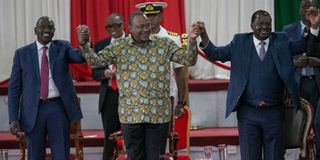Why political elite is fixated on BBI report

President Uhuru Kenyatta (centre), Deputy President William Ruto (left) and ODM leader Raila Odinga launch the Building Bridges Initiative task force report at Bomas of Kenya, Nairobi, on November 27, 2019. They should also focus on other pressing matters like malnutrition. PHOTO | PSCU
What you need to know:
- The Ministry of Health released the findings of a study that showed close to 40 per cent of Kenya’s 7.22 million children aged five years and below are undernourished.
The hottest topic in Kenya’s public square in recent days has been the report of the Building Bridges Initiative task force, which was released last Tuesday and launched with fanfare the next day.
The highlight of the BBI report is the proposal to tweak the country’s governance system once more to accommodate a few more members of the political elite so as to reduce election-related ethnic tensions or street protests in future.
Street protests following the disputed outcome of the last presidential election in 2017 officially cost about 30 lives (human rights watchdogs put the figure at more than 60), most of them victims of police bullets.
The biggest death toll attributed to election disputes in the country was the 1,133 recorded during the widespread violence in late 2007 and early 2008.
Concerns over a possible recurrence of violence in future elections resulting in even more deaths are understandable.
NUTRITION
But Kenyans also need to understand that this isn’t necessarily the major motivation of the self-serving political elite herding them towards another round of the battle for constitutional reforms.
In the grand scheme of things, the most important page in that BBI report is the one discussing who becomes president, prime minister, Cabinet ministers, and so on.
If the political elite cared about saving us from destruction, they would pay more attention to the daily killers that are claiming many more lives every year than all the election-related deaths combined.
Only days before the BBI report was made public, for instance, the Ministry of Health released the findings of a study that showed close to 40 per cent of Kenya’s 7.22 million children aged five years and below are undernourished – stunted, wasted or underweight.
FUNDING
The latest findings suggest that Kenya might not have improved its ranking on Global Hidden Hunger Indices and Maps, where it has been second to Niger, among African countries affected by multiple micronutrient deficiencies (iron, zinc, Vitamin A).
Poor nutrition not only puts these children at the risk of illnesses and death, but it also means that odds against them performing well in school are pretty high already. In a nutshell, their future is being killed this early in life.
The government has set a target to cut the number of children affected by stunting from the current 24.9 per cent to 14.5 per cent by 2030.
At face value the target appears realistic – it would take only a one percentage point improvement every year to get there.
But the cost would run into billions of shillings, and the government would have to make some tough choices allocating scarce resources.
Where, between a referendum to change the country’s governance system from a presidential one to a parliamentary one and a nutrition programme meant to prevent stunting in children, do you think your MP would allocate the budget money?
Your guess is as good as mine.





